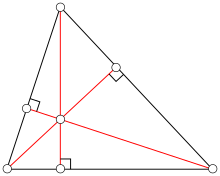
Back ارتفاع (مثلث) Arabic Вышыня трохвугольніка Byelorussian Вышыня трыкутніку BE-X-OLD Височина (триъгълник) Bulgarian Visina trougla BS بەرزی (سێگۆشە) CKB Виçкĕтеслĕх çӳллĕшĕ CV Höhe (Geometrie) German Ύψος τριγώνου Greek Alto (triangulo) Esperanto

In geometry, an altitude of a triangle is a line segment through a vertex and perpendicular to a line containing the side opposite the vertex. This line containing the opposite side is called the extended base of the altitude. The intersection of the extended base and the altitude is called the foot of the altitude. The length of the altitude, often simply called "the altitude", is the distance between the extended base and the vertex. The process of drawing the altitude from the vertex to the foot is known as dropping the altitude at that vertex. It is a special case of orthogonal projection.
Altitudes can be used in the computation of the area of a triangle: one-half of the product of an altitude's length and its base's length equals the triangle's area. Thus, the longest altitude is perpendicular to the shortest side of the triangle. The altitudes are also related to the sides of the triangle through the trigonometric functions.
In an isosceles triangle (a triangle with two congruent sides), the altitude having the incongruent side as its base will have the midpoint of that side as its foot. Also the altitude having the incongruent side as its base will be the angle bisector of the vertex angle.
It is common to mark the altitude with the letter h (as in height), often subscripted with the name of the side the altitude is drawn to.

In a right triangle, the altitude drawn to the hypotenuse c divides the hypotenuse into two segments of lengths p and q. If we denote the length of the altitude by hc, we then have the relation

For acute triangles, the feet of the altitudes all fall on the triangle's sides (not extended). In an obtuse triangle (one with an obtuse angle), the foot of the altitude to the obtuse-angled vertex falls in the interior of the opposite side, but the feet of the altitudes to the acute-angled vertices fall on the opposite extended side, exterior to the triangle. This is illustrated in the adjacent diagram: in this obtuse triangle, an altitude dropped perpendicularly from the top vertex, which has an acute angle, intersects the extended horizontal side outside the triangle.
© MMXXIII Rich X Search. We shall prevail. All rights reserved. Rich X Search

